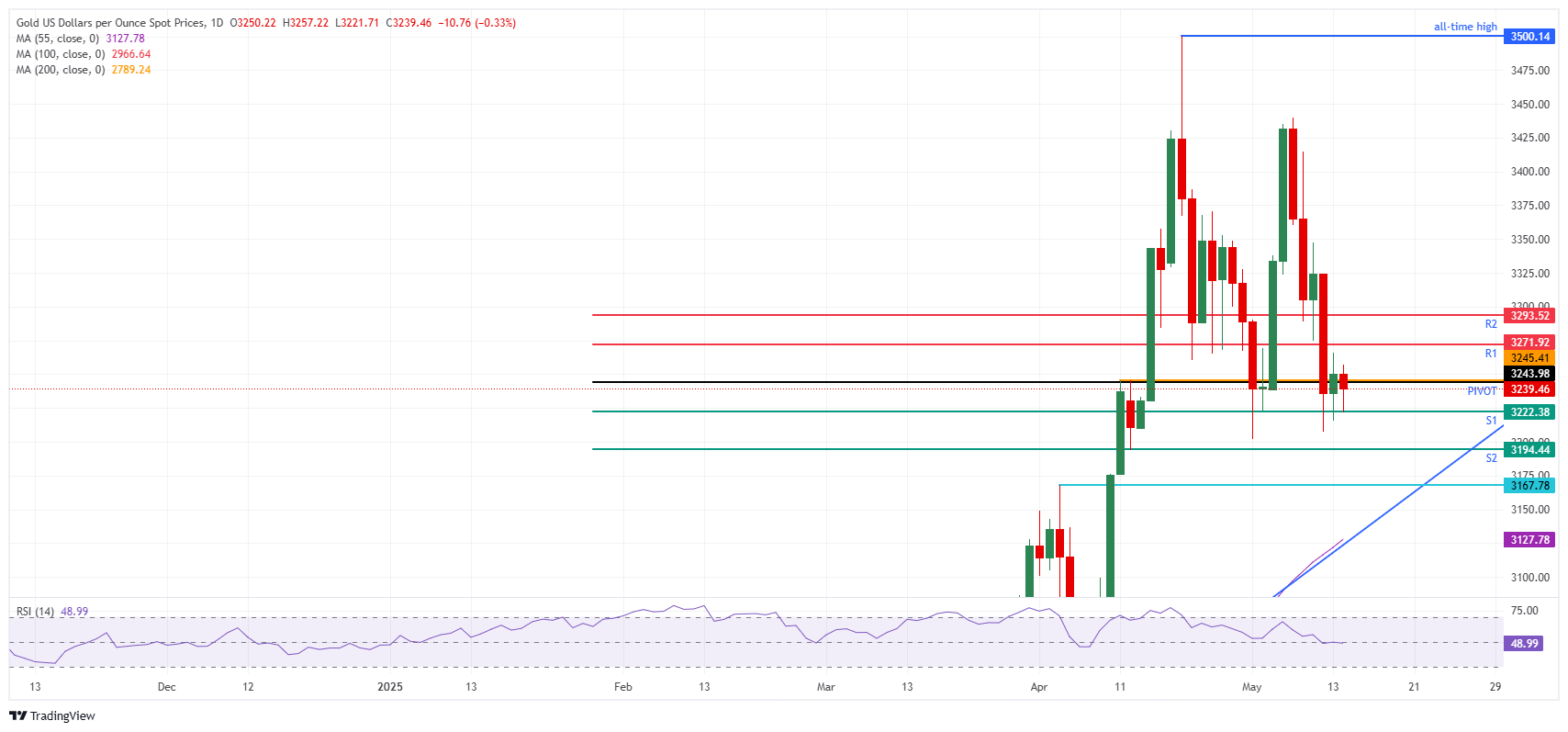- The price of gold erases Monday’s profits and makes this week’s performance into a loss.
- The operators are considering the perspectives of interest rate cuts by the Fed while balance the risks in the actions.
- More falls for gold could come if President Trump announces more trade agreements.
Gold (Xau/USD) goes back to $ 3.225 on Wednesday while facing new departures, erasing almost all earnings recorded on Tuesday. The softest inflation data than expected for April, published on Tuesday, provided a relief sigh for markets, since the dreaded inflationary shock by tariffs is not yet materialized. The lowest reading than expected for both the monthly general component and for the nucleus promoted a relief rally in the shares and led investors to provide for more rates cuts by the Federal Reserve (Fed) for this year.
Without high -level data publications for Wednesday in the economic calendar, the markets will seek more clues after President Donald Trump visited Saudi Arabia and ensure $ 600,000 million in commercial agreements. On Thursday, it is said that Ukrainian President Volodymyr Zelenskyy is ready to meet with Russian President Vladimir Putin in Istanbul for peace conversations, although Putin has not confirmed his assistance. Both Europe and the US have urged Putin to go to Istanbul, while new sanctions such as countermeasures are being considered if peace conversations are not carried out.
What moves the market today: Alaska’s gold mine faces tariffs
- Gold faces more down pressure, confirm several gold analysts and operators to Bloomberg. “Tariff rates between the US and China materially surprised down, which relieves investors’ concerns about trade -driven growth risks,” said Justin Lin, an analyst at Global X ETFS. “It is likely that capital is flowing outside the defensive and gold sectors,” he added.
- Even so, the recovery of gold may not have exhausted its impulse, according to Amy Lo, Chief of Heritage Management of UBS in Asia. UBS Group AG clients are increasingly changing assets in US dollars, opting instead of gold, cryptocurrencies and investments in China. “Gold is becoming very popular,” Amy said in an interview with Yvonne Man in the New Voices of Bloomberg on Tuesday in Hong Kong.
- India’s commercial deficit was probably reduced to 18.9 billion dollars in April from 21,500 million in March. The contraction in the deficit was partly due to a fall in gold imports; An increase in prices probably reduced metal demand. A heavy fall in crude oil prices is also expected to reduce oil imports, counteracting a typical seasonal increase in volumes.
Technical analysis of the price of gold: not breaking yet
Despite the sale pressure on Wednesday, a new minimum for this week has not materialized since the minimum of Monday at $ 3.207 has not been tested. Gold seems to be in a consolidation stage, with lower and highest higher. Anyone who breaks will first see an additional monitoring of $ 3,300 or $ 3,200.
The daily pivot point in $ 3,243 needs to be recovered first in case of any recovery. In case of a break, outside the consolidation, the R1 in $ 3,271 will undoubtedly be proven. Not far from there, the R2 at $ 3,293 is possibly the last level that will offer firm resistance before entering the $ 3,300 area again.
Downward, the daily S1 support at $ 3,222 already offered a wide support in Asian trade. In case a breakup, look for the S2 at 3,194 $ before the key technical support in $ 3,167 appears.

Xau/USD: Daily graphic
FAQS GOLD
Gold has played a fundamental role in the history of mankind, since it has been widely used as a deposit of value and a half of exchange. At present, apart from its brightness and use for jewelry, precious metal is considered an active refuge, which means that it is considered a good investment in turbulent times. Gold is also considered a coverage against inflation and depreciation of currencies, since it does not depend on any specific issuer or government.
Central banks are the greatest gold holders. In their objective of supporting their currencies in turbulent times, central banks tend to diversify their reserves and buy gold to improve the perception of strength of the economy and currency. High gold reserves can be a source of trust for the solvency of a country. Central banks added 1,136 tons of gold worth 70,000 million to their reservations in 2022, according to data from the World Gold Council. It is the largest annual purchase since there are records. The central banks of emerging economies such as China, India and Türkiye are rapidly increasing their gold reserves.
Gold has a reverse correlation with the US dollar and US Treasury bonds, which are the main reserve and shelter assets. When the dollar depreciates, the price of gold tends to rise, which allows investors and central banks to diversify their assets in turbulent times. Gold is also inversely correlated with risk assets. A rebound in the stock market tends to weaken the price of gold, while mass sales in higher risk markets tend to favor precious metal.
The price of gold can move due to a wide range of factors. Geopolitical instability or fear of a deep recession can cause the price of gold to rise rapidly due to its condition of active refuge. As an asset without yield, the price of gold tends to rise when interest rates lower, while the money increases to the yellow metal. Even so, most movements depend on how the US dollar (USD) behaves, since the asset is quoted in dollars (Xau/USD). A strong dollar tends to keep the price of gold controlled, while a weakest dollar probably thrusts gold prices.
Source: Fx Street
I am Joshua Winder, a senior-level journalist and editor at World Stock Market. I specialize in covering news related to the stock market and economic trends. With more than 8 years of experience in this field, I have become an expert in financial reporting.







